Flying with an infant in arms can be very economical but it isn’t always the easiest! Following these tips for flying with an infant on lap will help you be better prepared and can ease the stress and headache that can accompany flying with little kids. After all, a little preparation can make all of the difference between an absolute meltdown and just a few normal hiccups.
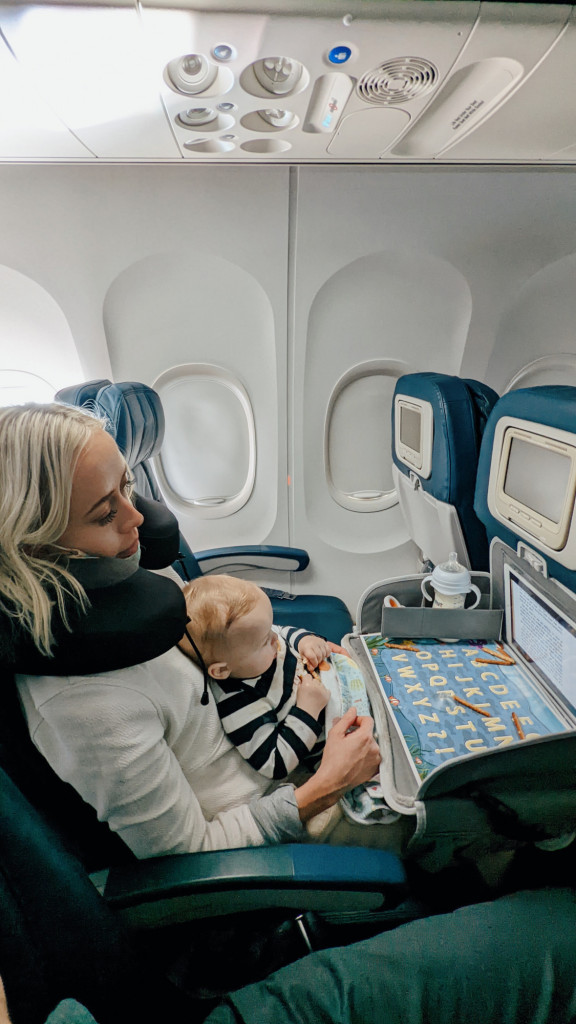
Tips for Flying With An Infant On Lap
Before we get into the specific tips for flying with an infant on lap, it is important to address some of the common questions when flying with your baby! Knowing this general information will help you be even more prepared to handle a long flight with a baby or other little children.
Information You Absolutely Need to Know Before Flying with an Infant on Lap
These are some of the most common questions and answers to flying with an infant on lap. This section will cover everything from how much it can cost, to what is the safest option, and everything in between.
What is infant in arms or infant in lap?
A lap infant or an infant in arms is a child under the age of 2 years old, who flies WITHOUT his or her own seat and instead sits on the lap of their caregiver.
How old does my child need to be to fly?
Some airlines, like American Airlines, allow a child to fly when they are only two days old. Others have a more standard rule of 14 days. If you are unsure, it is best to check with your airline provider first.
What is the safest way for baby to fly?
The AAP (American Academy of Pediatrics) recommends that the safest way for your little one to fly is in their own seat in a proper FAA-approved seat restraint. However, flying with your baby on your lap is still statistically safer than driving with your baby in a car seat. That is why the FAA recommends babies have their own seats and use a car seat, but they don’t require it. When you are determining what to do and what works best for your family, be sure to consult your pediatrician.
How to prevent babies’ ears from hurting on the airplane
Just like adults babies can get ear pressure on the airplane, particularly during take-off and landing. The best way to combat this is to be prepared with a pacifier, or a bottle for your little one to have during take-off and landing. If you aren’t sure your baby will take a pacifier or will be hungry for a bottle, it can be advantageous if your baby is old enough to fill a bottle with their favorite juice or a drink that they don’t get often. This will help encourage them to drink to ease the ear pressure and lessen any fussiness or crying.
Do airlines check infant age?
If you are flying internationally, then yes your airline will check the age as they require a passport. However, most US domestic flights do not check your infant’s age after you give it to them when booking their flight.
What documentation do you need for an infant to fly?
When you are flying with a baby on your lap, you will need a separate ticket issued by the airline, even if it is free. You can do this by calling the airline and asking them to add your baby to your ticket. They will usually ask the age of your infant and then any other specific information they might need. They then will issue a special “infant in arms ticket” for your little one. If you are flying internationally, you absolutely need a passport for your infant (more on that below)!
Also don’t forget that if you are flying internationally with your baby and their other parent isn’t present, you need a travel consent form.
You can read all about a travel consent form and download a template here!
Do infants need passports?
When flying internationally, yes! Any baby or child will need a passport when flying internationally regardless of age.
Is a diaper bag considered a carry-on?
On most major US airlines, diaper bags can be brought on in addition to your carry-on and personal item. This means as a parent that you can bring your carry-on luggage, your purse/backpack, AND the diaper bag! However, some reduced fare airlines like Allegiant and Spirit may charge you for them.
At what age do airlines charge for babies?
Most domestic airlines will allow babies to fly for free as an infant in arms ticket under the age of two. At the age of two airlines will require that your baby has their own seat and you will need to pay for it. International flights and airlines are a bit different. Flying with a baby under the age of two as an infant in arms internationally on international airlines like AirFrance, KLM, etc… will usually cost you about 10% of the normal ticketed fare.
What airlines charge for infants in laps?
Most domestic US airlines (Delta, United, JetBlue, American, Southwest, Alaska, etc…) issue “infant in lap” or “infant in arms” tickets for free. Air Canada also issues “infant in lap” tickets for free when flying domestically in Canada. However, other international airlines like Qatar, Singapore Air, KLM, etc… have a small charge (usually a small fee and then the taxes and fees) to issue an infant in arms ticket. The best way to find out if the airline you are flying will charge for an infant on lap ticket is to search the airfares site for “infant on lap” or “infant in arms’ ‘ or to call the helpline.
Can a lap child fly first class?
In most cases, yes! In fact, Delta Airlines and other carriers have even released statements supporting parents who fly infants in arms or infants on laps in first class.
*We have flown several times with an infant in arms in first class. I will say that all of our experiences have been positive. However, right now as Benson is REALLY active and is kind of a nightmare on flights I am sticking to the midrange class of airfare (on Delta this is Comfort+). Before you drop a bunch of money or points on first-class you might want to consider if you will be able to enjoy the amenities if you are wrangling a baby and if it might be a better idea to save up that cash or those points for a first-class flight later.
What can you bring in your diaper bag on an airplane?
You can pack your diaper bag as normal. Any liquids will need to be checked as you go through security. Just make sure that you don’t have any scissors or sharp objects.
Can I bring water for baby formula on the plane?
Yes! TSA allows water and baby formula and food in “reasonable quantities” in carry-on bags. Although, be aware that it will most likely go through a quick additional screening process.
Where should you sit on a plane with a baby?
If you can, try to score a bulkhead row and avoid the back of the airplane. The further you sit in the back of an airplane the more you can feel turbulence. Holding a baby during intense turbulence can be a bit intimidating for some. The bulkhead rows have quite a bit more space which can be really helpful if you need to bounce your baby around or get up and walk.
Can I breastfeed or pump on an airplane?
Yes, in fact, most airlines won’t charge you extra for bringing your breast pump along. If you plan to nurse or pump while on the airplane you might want to consider booking a window seat if you would like a bit more privacy.
Can I wear my baby on the airplane?
Most airlines will allow baby carriers to be used during the duration of the flight with the exception of take-off and landing. Some airlines will also allow you to wear your baby during take-off and landing. If you are wondering what your airline’s policies are, just call and ask ahead of time.
Can I wear my baby through the TSA security checkpoints?
Yes! Make sure that you don’t have anything stored in any of the compartments and that it doesn’t have metal buckles.
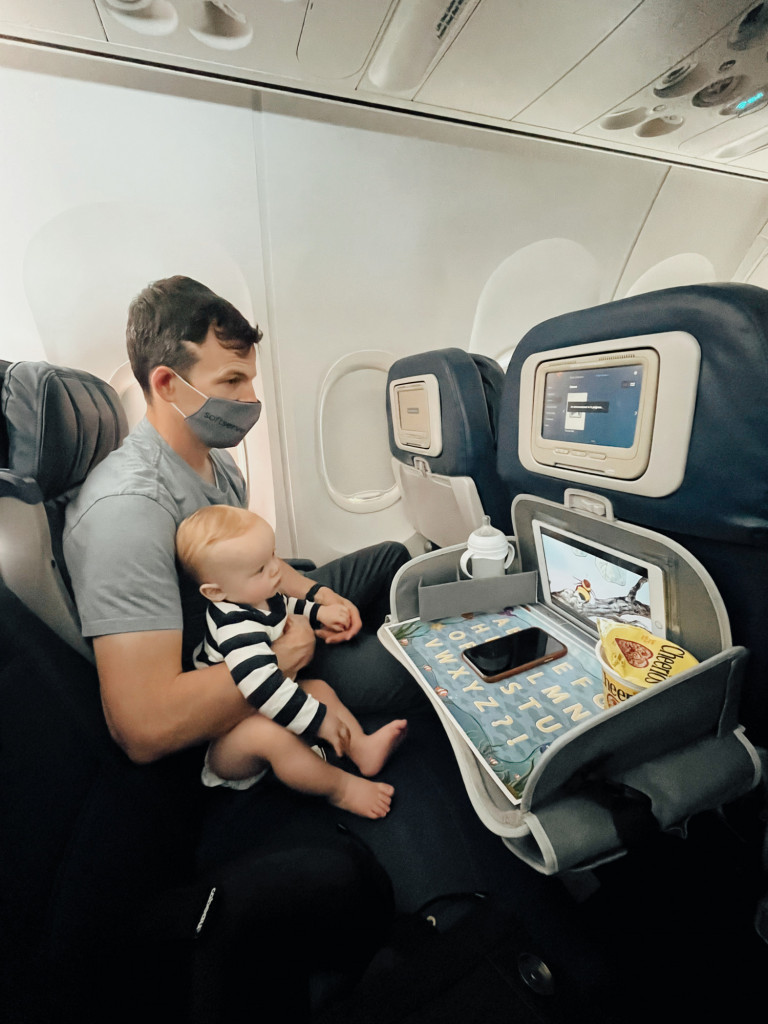
20 Tips For Flying With An Infant On Lap
Now that we have most of the common questions about flying with a baby covered let’s dig into the best tips for flying with an infant on lap.
Be early!
We suggest that you allow yourself at least an extra 30 minutes when you are flying with a baby. Adding another 30 minutes to your airport routine can help minimize the stress of trying to rush through the airport. You never know when you will need to change a diaper, feed, etc.. and having a bit of extra time can ease your mind.
Have TSA Precheck or Clear
TSA Precheck or Clear are game-changers when flying with kids and babies. Life is so much easier when you aren’t trying to pull all of your liquids and electronics out of your bag, take off your shoes, remove your jacket, AND hold your baby. The best part of TSA Precheck is that if you as the parent have precheck, it is automatically passed down to your kids who are under the age of 12.
If you don’t want to pay for TSA Precheck or Clear, here is a list of some of the credit cards that currently give you a free TSA Precheck or Clear credit.
- IHG One Rewards Premier Credit Card
- United Explorer℠ Card
- Capital One Venture Rewards
- Capital One Venture X
- Delta SkyMiles® Platinum Business American Express Card (one of my favorites!)
- Marriott Bonvoy Brilliant® American Express® Card
- United Club℠ Infinite Card
- The Platinum Card® from American Express
- Chase Sapphire Reserve®
- Southwest Rapid Rewards® Premier Credit Card
- The Business Platinum Card® from American Express
Haters are going to hate. Be okay with a few dirty or annoyed looks.
Almost every flight that I have been on with my little ones has garnered me at least one dirty or annoyed look. Honestly, most people are going to be really supportive and kind but be prepared that there might be someone who isn’t. Let those people go, and focus on the people around you who are happy and nice. Don’t worry about pleasing the person 3 rows in front of you who keeps shooting you a dirty look with each little whimper your baby makes.
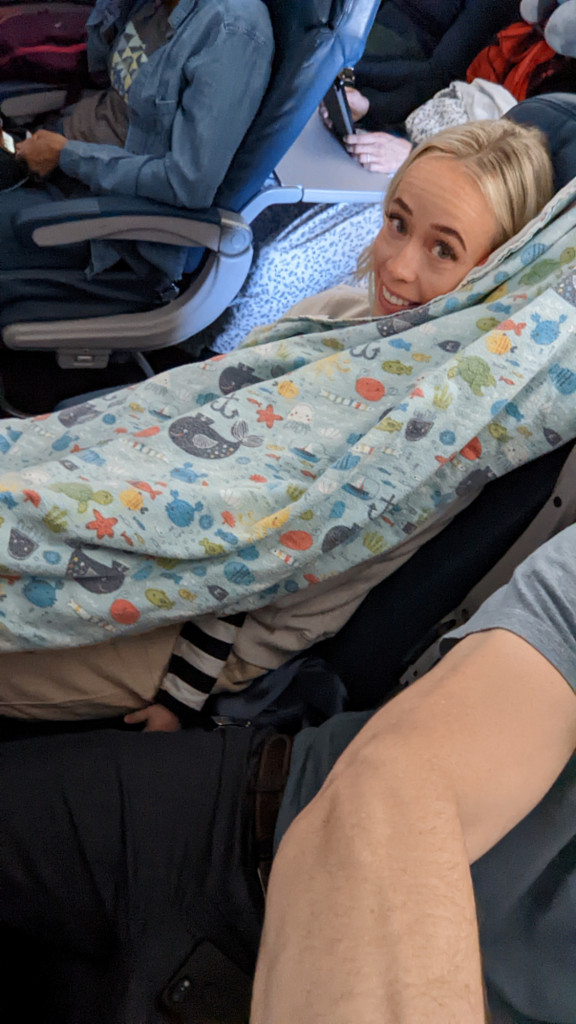
Consider flying during nap, sleep, or happy times.
If your little one has a standard “witching hour”, avoid flying during that time! Flying early in the morning where your baby can snuggle you can catch some extra zzzz’s or flying red-eye can be advantageous if your little one is used to sleeping in your arms.
Ask when you check-in if there are any extra seats!
It doesn’t happen all of the time so you don’t want to bank on it, but it doesn’t hurt to ask if there are any extra seats on the flight when you check-in. Usually, if there are, the agent can seat you next to the extra seat so you can use the extra space for your little one.
Attach loose items to you or your baby and bring caps and lids.
The airplane and airport are gross. There is no denying that. Having a pacifier clip or a bottle cap will save your sanity when trying to keep things off the floor.
Bring extra wipes, and then bring some more.
Don’t underestimate the power of wet wipes and extra baby wipes. You will not regret being able to wipe down and sanitize your area and quickly clean up a spit-up or blowout.
Consider double diapering.
If you have a long flight ahead and your baby is prone to have massive blowouts you might want to consider double diapering. It is best to put a slightly larger diaper on the outside. Of course, you still want and need to change your baby’s diaper regularly. However, sometimes those blowouts happen during taxi, take-off, and landing and you can’t take care of them immediately. Having a bit of extra protection can be super helpful.
Request a baby bassinet or the bulkhead.
If you are booking far enough in advance you should be able to request a bulkhead seat (a seat with more room) or a baby bassinet. Some airplanes don’t have baby bassinets but some do, so it never hurts to ask!
If you are flying with your spouse or partner, book the aisle and middle seat!
Here is a hack to potentially help you snag some extra space for your baby! Most aircraft have 3 seats in a row. If you are flying on an airplane with this seat configuration with your spouse/partner you want to book the aisle seat and the window seat and leave the middle seat open. The reason for this is that the middle seats are the last to go and you are giving yourself a higher chance that you will have some extra space for a baby on your flight!
If the middle seat ends up getting booked, just offer the person sitting there your window or aisle seat and have your partner/spouse move into the middle seat. This usually works great! The person who was going to be stuck in the middle now gets a better seat which can help with any frustration that may arise if your child or baby loses it.
*We do this every time we are flying in the main cabin or comfort+ with our babies. I would say about ⅓ of the time we get lucky and have the middle seat empty.
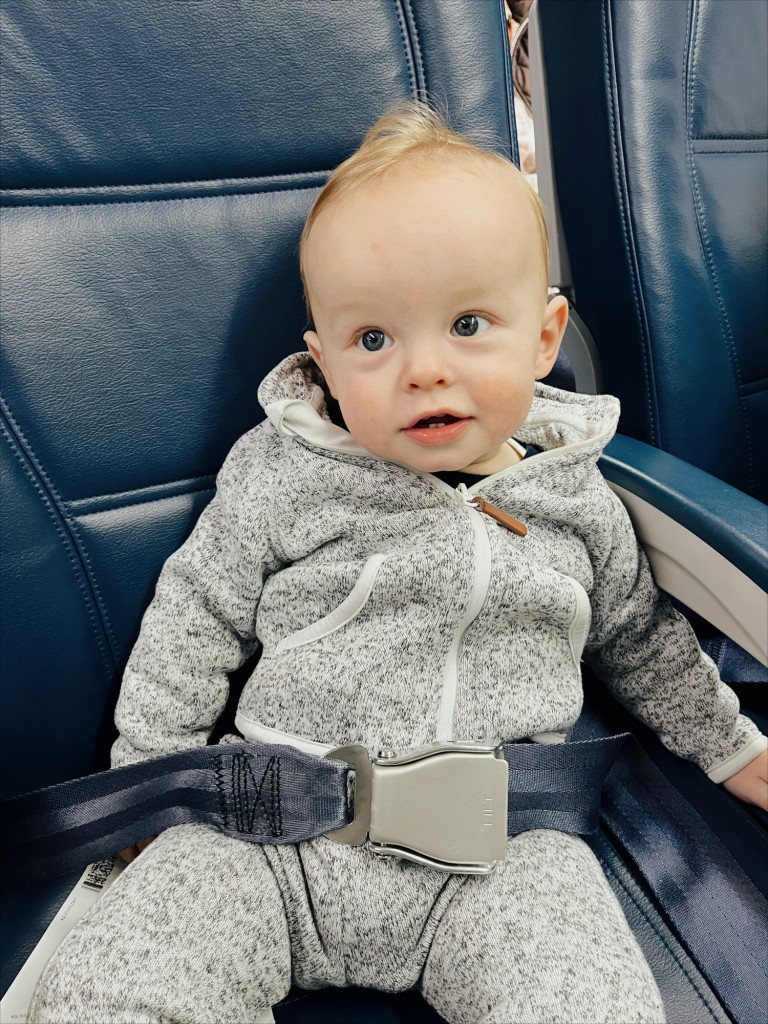
Stick to your baby’s routine.
If you read a book or two and then sing a song before bedtime at home, do those same things on the airplane. This will help your little one transition a bit better. One thing you don’t want to do is to stress too much about your baby’s schedule. Most of the time flights can throw your infant’s schedule off for a day, so don’t get worked up if they miss a nap.
Gate check your stroller.
If you are going to have a longer layover or have a wiggly little one, keep your stroller with you as you move through the airport, and then just gate check it as you board! This is so simple and easy and means that you will have your stroller almost immediately after you deplane. You will love having your stroller with you so you have a safe place for the baby to sit while you check-in, wait for your flight, and then wait for your luggage.
Take advantage of pre-boarding.
Most airlines allow families with young children who need extra time to preboard. Take advantage of this! Doing so allows you to get settled and situated. It also can help you snag some of that precious overhead compartment space.
Pack some new toys and activities that can help distract your little one.
Having a few new toys and activities that you can pull out on the airplane when your baby is getting fussy can really help! We have found that the little spinner toys that can attach to the tray table or window work awesome and can entertain for hours!
If you don’t want to buy new toys, hide your baby’s favorite toy for a week or so before your flight. Then pack it and let your little one play with it on the airplane.
Consider screen time.
There are some massive debates in the family travel world about allowing electronics on flights. We allow and even encourage it if it makes the flight easier. If you haven’t yet been introduced to “Hey Bear” on YouTube you need to give it a look. We have seen a dumb little “Hey Bear” animated song stop an absolute meltdown in its tracks. I try to download a few classic Disney movies or “Hey Bear” animated songs before we take off so I can quickly whip out my phone or iPad if needed.
Make sure you pack enough snacks, water, and diapers.
You can get by without new toys, episodes, or even rushing through the airport to get to your gate on time. However, if your baby is hungry and you aren’t able to feed them it will be an absolute disaster. Check and then double-check that you have what you need.
The best products for flying with an infant on lap
- A lightweight blanket that you can drape over your shoulder for nursing or sleeping babies.
- A tray table cover. Using a tray table cover is a game changer! It is a perfect place to hold bottles, snakes, iPads with movies, and toys.
- A sippy cup or bottle with a cap
- Pacifiers with lids
- Easy pour formula and snack containers
Pack an extra set of clothes for you and baby.
If you are flying with an infant on your lap and you are going to be taking your baby on a long flight you will want a change of clothes just in case there is a blowout or huge spit-up.
Get baby as much sleep the day before.
Don’t get sucked into the idea that skipping naps and having an overtired baby when you board the airplane is a good idea. Doing this plan backfires and you then have an overstimulated and overtired baby. Help your baby get as much sleep the day before a big flight and then try to stick to your routines and encourage sleep at the proper times on your flight.
Ask for and accept help.
If the kind stranger is offering to put your bag in the overhead bin while you get your little one settled in his seat, let them! Don’t try to do it all on your own if you don’t have to. If you feel comfortable asking someone to help you fold up a stroller, ask!
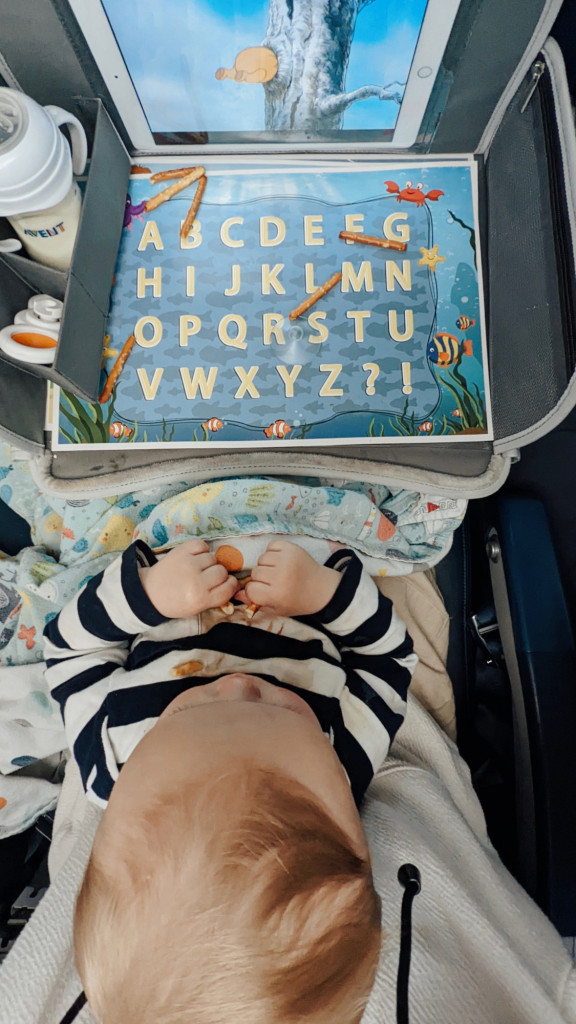
Be patient with yourself and with your little one.
Have realistic expectations for yourself and your baby. It is okay if your baby cries. It is okay to get flustered. Even if your baby freaks out THE WHOLE flight, you most likely won’t ever see those people again. You are doing your best. Don’t forget to take care of yourself and give yourself some grace. Ensuring that you have had food, and sleep will help you be better prepared for flying with your baby! Remember that it is about the destination you will be at and the memories you will make there!

